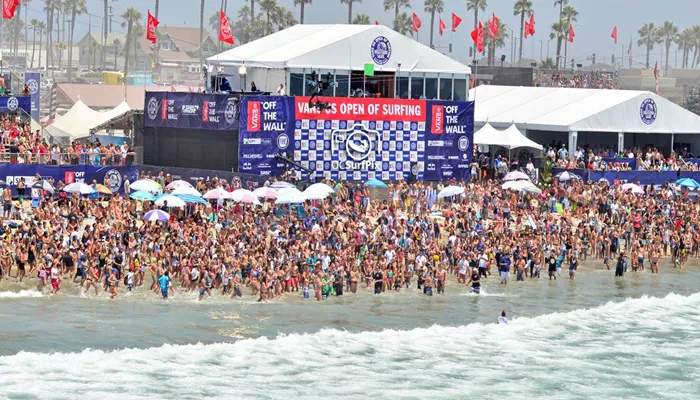Surfing is not just a sport; it is a culture, a lifestyle, and for many, a passion that transcends the ordinary. Among the myriad of surfing competitions held around the globe, one stands out as the largest and most prestigious: the US Open of Surfing. This annual event draws surfers from all corners of the world and captivates audiences with its thrilling displays of athleticism and skill. In this article, we will explore the history, significance, structure, and impact of the US Open of Surfing, highlighting why it is revered as the pinnacle of surfing competitions.
History And Evolution of The US Open of Surfing
The US Open of Surfing has its roots in Huntington Beach, California, which is often referred to as “Surf City USA.” The event was first held in 1959 and has evolved significantly over the decades. Initially a small local competition, it grew in stature and recognition as surfing gained popularity worldwide. By the late 20th century, it had transformed into a major professional event on the World Surf League (WSL) circuit.
The competition has seen numerous changes in its format and sponsorship over the years. Originally known as the “Huntington Beach Pro,” it was rebranded to the US Open of Surfing in 1994. The event has attracted some of the biggest names in surfing history, including Kelly Slater, Lisa Andersen, and more recently, surfers like John John Florence and Carissa Moore.
Event Structure
The US Open of Surfing typically takes place over eight days in early August. The competition features multiple divisions, including:
- Men’s Shortboard
- Women’s Shortboard
- Longboard
- Junior Men’s and Women’s
- Pro-Am events
This diverse range allows surfers of various skill levels to compete and showcase their talents. The event is part of the WSL Challenger Series, which serves as a qualification pathway for surfers aspiring to join the elite Championship Tour.
Location: Huntington Beach
Huntington Beach provides an ideal backdrop for this prestigious event. Known for its consistent waves and beautiful sandy beaches, it attracts thousands of spectators each year. The event footprint extends south of the Huntington Beach Pier, creating a vibrant atmosphere filled with food vendors, merchandise stalls, and entertainment options.
The beach’s iconic pier serves as a natural grandstand for viewers who come to witness not only the surfing but also various cultural activities that accompany the competition. From live music performances to art exhibitions, the US Open of Surfing offers an experience that goes beyond just sport.
Competition Format
The competition format is designed to ensure that only the best surfers advance through each round. Surfers compete in heats where they are judged based on their performance on waves. Key criteria include:
- Wave selection
- Maneuver variety
- Speed
- Power
- Flow
Judges score each surfer on a scale from 1 to 10, with scores being averaged to determine who advances to subsequent rounds. The final day culminates in thrilling championship heats where top surfers battle for victory.
Significance in Surf Culture
The US Open of Surfing holds immense significance within surf culture. It is not only a platform for showcasing talent but also a celebration of surfing as an art form. The event fosters community among surfers and fans alike, promoting camaraderie and respect for the ocean.
Moreover, it serves as an opportunity for up-and-coming surfers to gain exposure and experience competing at a high level. Many professional surfers credit their participation in events like the US Open as pivotal moments in their careers.
Economic Impact
The economic impact of the US Open of Surfing on Huntington Beach is substantial. The influx of visitors during the event boosts local businesses such as hotels, restaurants, and shops. According to estimates, the competition generates millions in revenue for the city each year.
Additionally, sponsors benefit from heightened visibility during this high-profile event. Major brands associated with surfing often use this platform to launch new products or campaigns aimed at surf enthusiasts.
Environmental Considerations
As with any large-scale event held at natural venues, environmental considerations are paramount. The organizers are committed to promoting sustainability practices during the US Open of Surfing.
Initiatives include beach clean-ups, waste reduction programs, and partnerships with environmental organizations to protect marine life.
Surfers themselves are often advocates for ocean conservation and use their platform to raise awareness about environmental issues affecting coastlines globally.
Notable Moments in History
Throughout its history, the US Open has witnessed numerous memorable moments that have become part of surfing lore:
Kelly Slater’s Dominance: Kelly Slater won his first US Open title in 1991 at just 19 years old. His subsequent victories solidified his status as one of surfing’s all-time greats.
Lisa Andersen’s Legacy: Andersen was one of the first female surfers to gain widespread recognition. Her victories in the 1990s helped pave the way for future generations of female surfers.
Historic Wins: In recent years, John John Florence’s back-to-back wins showcased his exceptional talent and solidified his place among surfing elites.
Conclusion
The US Open of Surfing stands as a testament to surfing’s growth from a niche activity into a global phenomenon. Its rich history, competitive structure, cultural significance, economic impact, environmental awareness initiatives, and memorable moments contribute to its status as not just an event but a celebration of surf culture itself.
Related topics:

